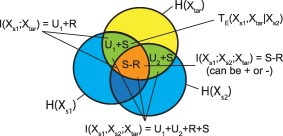Information theoretic measures can be used to identify nonlinear interactions between source and target variables through reductions in uncertainty. In information partitioning, multivariate mutual information is decomposed into synergistic, unique, and redundant components. Synergy is information shared only when sources influence a target together, uniqueness is information only provided by one source, and redundancy is overlapping shared information from multiple sources. While this partitioning has been applied to provide insights into complex dependencies, several proposed partitioning methods overestimate redundant information and omit a component of unique information because they do not account for source dependencies. Additionally, information partitioning has only been applied to time-series data in a limited context, using basic pdf estimation techniques or a Gaussian assumption. We develop a Rescaled Redundancy measure (Rs) to solve the source dependency issue, and present Gaussian, autoregressive, and chaotic test cases to demonstrate its advantages over existing techniques in the presence of noise, various source correlations, and different types of interactions. This study constitutes the first rigorous application of information partitioning to environmental time-series data, and addresses how noise, pdf estimation technique, or source dependencies can influence detected measures. We illustrate how our techniques can unravel the complex nature of forcing and feedback within an ecohydrologic system with an application to 1 min environmental signals of air temperature, relative humidity, and windspeed. The methods presented here are applicable to the study of a broad range of complex systems composed of interacting variables.
http://onlinelibrary.wiley.com/doi/10.1002/2016WR020216/full

